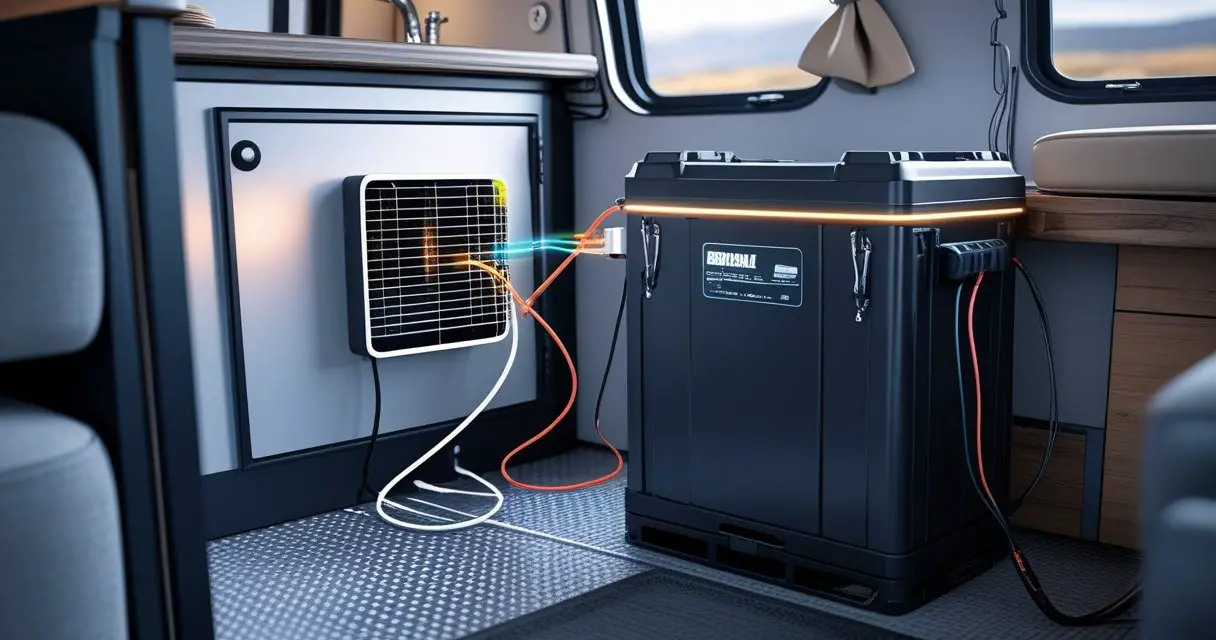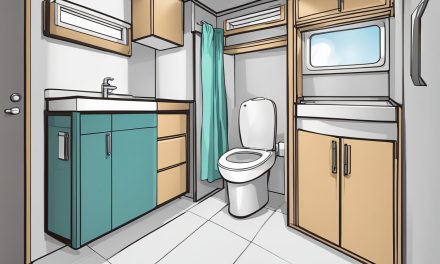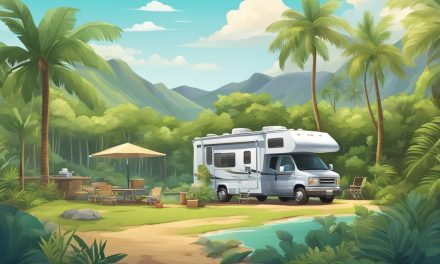Would you like to save this article?
Staying warm in an RV without shore power can be tricky, especially when temperatures drop. You might wonder if your heater can run on battery power alone.
Yes, most RV heaters can run on battery power, but the runtime depends on the heater type, battery capacity, and weather conditions. Understanding how your system works helps you plan better for cold nights on the road.
Electric heaters draw a lot of power and can drain a standard RV battery in just a few hours. Propane furnaces use gas for heat and only rely on the battery to power the fan and ignition, making them far more efficient for off-grid use.
If you want to make your battery last longer, small changes like improving insulation, lowering thermostat settings, or adding solar support can help. Exploring these options ensures you stay comfortable while keeping your power supply steady through the night.
Key Takeaways
- RV heaters can run on battery power, but runtime varies by type and conditions
- Managing power use and insulation improves heating efficiency
- Backup energy sources extend comfort during off-grid camping
How RV Heaters Operate on Battery Power
Your RV heater can use battery power to run key components, but it depends on the type of system installed. Most propane furnaces need 12-volt DC power for the fan and electronics, while electric heaters rely on higher wattage that drains batteries quickly.
Types of RV Heaters and Power Requirements
RV heaters usually fall into two main categories: propane furnaces and electric heaters.
A propane furnace burns fuel for heat but still depends on your 12-volt battery to power the ignition and blower fan.
Without a charged battery, the furnace cannot start or circulate warm air. Electric heaters draw power directly from your electrical system.
Most portable electric heaters use 500 to 1,500 watts, which can deplete a standard RV battery within hours.
Because of this, electric heaters work best when you’re connected to shore power or using a generator.
| Heater Type | Power Source | Battery Dependency | Typical Runtime |
|---|---|---|---|
| Propane Furnace | Propane + 12V battery | Moderate (fan + ignition) | 8–12 hours per battery |
| Electric Heater | 120V AC or inverter | High (very short runtime) | 2–10 hours depending on capacity |
Role of the Furnace Fan in Battery Usage
The furnace fan plays a major role in how long your battery lasts. It pushes heated air through ducts and runs on 12-volt DC power.
When the thermostat triggers the furnace, the fan cycles on and off, drawing several amps each time. If your battery charge drops too low, safety switches may shut down the system to stop propane flow.
A single deep-cycle battery might power the fan for one night, but colder weather or frequent cycling shortens runtime.
You can extend battery life by adding extra batteries, upgrading to lithium-ion units, or using solar panels to recharge during the day.
Keeping your fan motor clean and the ducts clear also reduces strain on the system and lowers power draw.
Propane Versus Electric Heaters in RVs
Propane heaters are more efficient for off-grid use because they rely mainly on fuel, not electricity. They use minimal battery power for startup and air circulation, making them practical for dry camping or boondocking.
You only need to monitor propane levels and keep your 12-volt system charged. Electric heaters, in contrast, need continuous electrical supply.
Running one from batteries alone is rarely practical unless you have a large battery bank and inverter. Even then, the runtime remains short.
For most RV owners, a propane furnace supported by a healthy battery system provides the best balance between comfort, safety, and power efficiency.
Battery Capacity and Heater Runtime
Your RV heater’s runtime depends on the size and type of battery, the heater’s power draw, and environmental conditions. Understanding how these factors interact helps you plan heating use and manage power efficiently.
Factors Affecting Battery Drain
Several factors determine how quickly your RV furnace drains the battery. The most important are battery capacity, heater power draw, and system efficiency.
Battery capacity is measured in amp-hours (Ah). A 100Ah deep-cycle battery provides roughly 50 usable amp-hours since most batteries shouldn’t discharge below 50%.
The more capacity you have, the longer your heater can run before recharging. The heater’s current draw also matters.
A typical propane furnace fan uses 7–10 amps, while an electric heater may draw over 100 amps at 12 volts. High-draw devices shorten runtime significantly.
Other factors include battery age, wiring condition, and inverter losses. Old or poorly maintained batteries lose capacity and recharge less efficiently, reducing available power for heating.
Estimating Runtime for Different Battery Setups
You can estimate runtime by dividing usable battery capacity by the heater’s current draw. The formula is:
Runtime (hours) = Usable Amp-Hours ÷ Heater Amps
| Battery Setup | Usable Capacity (Ah) | Heater Draw (Amps) | Approx. Runtime |
|---|---|---|---|
| Single 100Ah AGM | 50 | 7.5 | ~6.5 hours |
| Two 100Ah AGM (200Ah total) | 100 | 7.5 | ~13 hours |
| 100Ah Lithium | 90 | 7.5 | ~12 hours |
Lithium batteries offer more usable capacity—up to 90%—and maintain voltage better under load. For extended heating, combining multiple batteries or adding solar charging can help maintain comfort without frequent generator use.
Impact of Temperature and Usage Patterns
Cold temperatures reduce battery efficiency and increase heater demand. At freezing levels, a battery’s usable capacity can drop by 20–30%.
The furnace also runs more often to maintain cabin warmth, drawing more current. Your usage habits strongly affect runtime.
Running the heater continuously drains power faster than cycling it at moderate intervals. Lowering thermostat settings or using extra insulation reduces heater workload.
Using fans, vent covers, and thermal curtains helps retain heat so your furnace cycles less often. Managing temperature settings carefully can extend usable battery time and keep your RV comfortable through the night.
Optimizing Battery Performance for Heating
Efficient heating depends on having the right power source and keeping it in good condition. The type, capacity, and care of your battery directly affect how long your RV heater can run and how well it performs in cold conditions.
Choosing the Right Battery for Your RV Heater
Selecting a suitable battery helps you maintain reliable heat when camping off-grid. Deep-cycle batteries are ideal because they deliver steady power over time.
Common options include AGM, lithium-ion, and flooded lead-acid batteries.
| Battery Type | Typical Capacity (Ah) | Key Advantages | Drawbacks |
|---|---|---|---|
| AGM | 70–120 | Low maintenance, sealed design | Heavier, shorter lifespan |
| Lithium-ion | 100–300 | Lightweight, longer life, fast charging | Higher cost |
| Flooded Lead-Acid | 80–200 | Affordable, widely available | Requires maintenance |
For most RV heaters, a 100Ah deep-cycle battery can provide several hours of use. Lithium batteries perform better in cold weather and handle deeper discharges without damage.
If you use an electric heater, you may need multiple batteries or a hybrid setup with propane to reduce electrical load.
Battery Maintenance and Charging Tips
Proper maintenance extends battery life and ensures consistent heater performance. Keep terminals clean and connections tight.
Check voltage levels regularly—discharging below 50% can shorten lifespan for most lead-acid batteries. Charge your battery using a smart charger or solar system that matches its chemistry.
Avoid overcharging, which can cause heat buildup and reduce efficiency. During storage, disconnect the battery and keep it in a cool, dry place.
Recharge it every few months to prevent sulfation. Monitoring tools like a battery monitor or voltage meter help track energy use and maintain readiness for your next trip.
Alternatives and Backup Power Sources
When your RV battery cannot supply enough power for heating, you can turn to other energy sources to keep your system running. Reliable options include generators for direct electrical support and solar setups for steady battery charging.
Using a Generator to Support Heating
A generator provides a stable backup when your RV battery runs low. It can power the furnace blower, ignition system, and other electrical components that need 12-volt or 120-volt current.
You can use either a built-in or portable generator. Built-in models connect directly to your RV’s electrical system, while portable ones require an external hookup.
Both types can run on gasoline, diesel, or propane, depending on your setup. Keep fuel supply and noise limits in mind.
Many campgrounds have quiet hours, so a low-decibel generator is better for shared spaces. Always operate it outdoors with proper ventilation to prevent carbon monoxide buildup.
Tip: Run the generator for short periods to recharge your RV battery rather than keeping it on constantly. This approach saves fuel and reduces wear on the unit.
| Generator Type | Common Fuel | Key Advantage |
|---|---|---|
| Built-in | Gasoline/Diesel | Integrated power supply |
| Portable | Gasoline/Propane | Flexible and easy to store |
Solar Power and Other Charging Options
Solar panels can recharge your RV battery during daylight, helping maintain heater operation without relying on fuel. A solar setup includes panels, a charge controller, and a battery bank.
The system converts sunlight into electricity that keeps your 12-volt system powered. Solar power works best in sunny areas and can extend your off-grid time.
However, cloudy weather or short winter days reduce output. You may need extra panels or a larger battery bank for colder climates.
Other charging methods include shore power hookups at campgrounds and vehicle alternators that charge the battery while driving. Combining solar and generator power gives you flexibility and helps prevent battery depletion during extended stays without hookups.
Regularly check battery voltage and connections to ensure efficient charging and safe heater operation.
Common Challenges and Solutions
Running an RV furnace on battery power requires attention to both energy use and system reliability. Managing battery drain and ensuring proper power delivery helps maintain heat through the night and prevents damage to electrical components.
Preventing Battery Drain Overnight
Your RV furnace fan and ignition system rely on 12‑volt power, which can quickly drain a small battery bank. A typical furnace draws about 7–10 amps, meaning a 100Ah battery may last only 6–8 hours before reaching 50% capacity.
Use these methods to extend runtime:
- Add insulation around doors, windows, and vents to reduce heat loss.
- Lower the thermostat a few degrees while sleeping.
- Cycle the furnace instead of running it constantly.
- Upgrade to lithium batteries, which maintain voltage better in cold weather.
- Install a battery monitor to track voltage and prevent deep discharge.
If you camp off‑grid often, consider solar panels or a portable generator to recharge batteries daily. Keeping your battery above 12.2 volts helps protect capacity and ensures the furnace ignitor works correctly.
Troubleshooting Heater Power Issues
When the RV furnace fails to start or shuts off early, the cause is often low voltage or poor connections. Check battery voltage first; it should read above 12.5 volts when the furnace tries to ignite.
If voltage is normal, inspect fuses, wiring, and terminals for corrosion or loose contacts. A weak connection can interrupt power to the blower motor or control board.
Listen for the ignitor clicking. If you hear it but the heater doesn’t fire, the problem may be propane flow or ignition timing, not the battery.
Keep a small multimeter in your RV to test circuits quickly. Regular maintenance—cleaning terminals, tightening grounds, and checking airflow—helps prevent furnace power issues.
RV Community Insights and Real-World Experiences
Many RV owners share practical knowledge about heating systems through forums and social groups. Their experiences show how battery capacity, weather, and heater type affect performance when camping without shore power.
Popular Discussions from RV Forums
RV forums often compare propane furnaces and 12-volt electric heaters. Most RV furnaces use propane for heat but rely on the battery to power the blower fan.
This means the furnace can run off battery power, but only for as long as the battery charge lasts. Common posts describe boondocking situations where a single deep-cycle battery runs the furnace fan for about 8–12 hours before voltage drops too low.
Many users recommend upgrading to lithium batteries or adding solar panels to extend runtime. Forum members also discuss portable 12-volt heaters, noting they are mainly for defrosting or small spaces, not heating an entire RV.
They often warn that high-wattage electric heaters drain batteries quickly and are better suited for use when plugged into shore power or a generator.
| Common Topic | Typical Community View |
|---|---|
| Propane furnace power draw | Moderate; depends on fan speed |
| 12-volt heater use | Limited to short-term or small areas |
| Battery upgrades | Strongly recommended for longer stays |
Advice from Experienced RV Owners
Experienced RVers emphasize energy management. They suggest monitoring your battery level closely, especially overnight when the furnace cycles more often.
Many recommend using a battery monitor to track voltage and prevent deep discharge.
You’ll find advice to insulate windows and doors to keep heat inside and reduce furnace runtime. Some owners use extra blankets or thermal curtains to conserve energy.
Veteran travelers also share that propane use is usually more efficient for heating. They advise saving battery power for lights, fans, and electronics instead of electric heaters.
A few owners describe success combining solar charging with propane furnaces. This allows longer off-grid stays without needing a generator.





